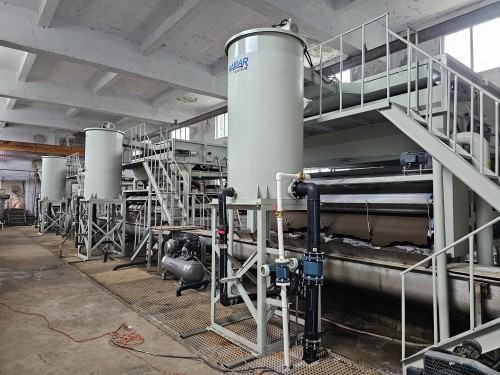In July 2025, a municipal wastewater treatment plant in Liaoning, China, successfully completed a comprehensive upgrade of its sludge dewatering system. The final legacy dewatering unit—having been in continuous operation for nearly 20 years—was replaced with our latest equipment (add equipment series number). With all three machines now fully modernised using our technology, the plant has significantly improved both its operational efficiency and sludge treatment reliability.
Dewatered sludge now consistently meets target moisture levels, and the plant operator has expressed strong satisfaction with the outcome.
Operational Challenges from Ageing Equipment
Prior to the upgrade, the facility had been grappling with the challenges of ageing dewatering infrastructure. The legacy machines over time had become increasingly unreliable and costly to maintain:
• Mechanical failures were frequent, including roller fractures and filter belt misalignment, resulting in repeated downtime and high maintenance costs.
• Suboptimal dewatering performance led to higher residual moisture in sludge cake, negatively affecting downstream processing and disposal.
• Insufficient capacity, with each unit handling only 2–3 m³/hour of sludge cake, was creating bottlenecks as treatment demand steadily increased.
System Upgrade with High-Efficiency Dewatering Technology
In 2024, the facility initiated phased upgrades by installing two of our new-generation sludge dewatering units. Following a full year of smooth, stable performance, the final ageing machine was replaced in July 2025, completing the transition.
The key technical advantages of the new equipment supplied by Haiba include:
• Improved solids capture and reduced moisture content: Sludge cake moisture is now consistently maintained below 80%, exceeding prior performance and meeting on-site operational standards.
• Significantly enhanced throughput: Each new unit processes 4–5 m³/hour of sludge cake (depending on inlet conditions and operational parameters), representing a 40–60% increase in treatment capacity.
• Robust and reliable operation: Reinforced structural components and optimised belt tracking systems minimise mechanical issues such as roller damage and belt drift, greatly reducing maintenance frequency and unplanned downtime.
Results and Outlook
The upgrade has delivered clear operational benefits—resolving long-standing equipment issues, increasing sludge processing capacity, and reducing total cost of ownership through improved reliability and lower maintenance demand.
Looking ahead, we remain committed to supporting wastewater treatment facilities with adaptable, high-performance dewatering solutions tailored to the practical realities of day-to-day operations. Our goal is to continue helping operators enhance efficiency, ensure compliance, and reduce environmental and operational risk.
(Photo: On-site at the wastewater treatment plant)
Post time: Aug-06-2025
